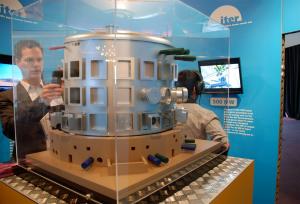Fusion joins the energy debate in Maastricht
The challenge is summarized by two lines.
One line shows the energy demand of the world's population, which has just exceeded the seven billion mark; extrapolated into the future, this line shows a steep incline. The second line representing the world's supply of fossil fuels slopes downward almost as sharply. The question is: How do we fill the gap between the two trajectories? What technologies are available now or will become available in the future? Which are technologically and economically feasible? And also: How can we reduce greenhouse gas emission by 80 percent within the next 40 years, as indicated in Europe's ambitious Energy Roadmap 2050?
"If we make the right choices, the transformation is feasible," Günther Oettinger, Europe's Commissioner for Energy, said last week as he opened the European Energy Conference in Maastricht, the Netherlands.
It was not by coincidence that the conference chairmen, Harald Bolt and Fritz Wagner, had chosen the birthplace of the European Union as the location for this showcase for both available and yet-to-be-developed energy technologies and energy policies.
"In order to meet the ambitious goal of reducing CO2 emissions by 50 percent by 2050 and to meet the ever increasing energy demand, more than 40 times the current annual investment will be needed for the development of new energy technologies at a global scale," Herve Pero, Director General for Research within the European Commission, pointed out. "This looks almost impossible against the backdrop of the economic crisis," he continued, announcing the revision of Europe's current Strategic Energy Technology Plan (SET). "We need to go beyond technologies. We need a long term vision ..."
This message was also stressed by Javier Solana, former Secretary General of NATO and Secretary General of the Council of the European Union in his keynote lecture: "The measures we have are our minds ... to make this world a better world."
Besides updates on the status of wind and solar energy projects, carbon capture and sequestration technologies, and material research, fusion made its way onto the European energy stage. ITER Director-General Osamu Motojima presented the status of the ITER project followed by Francesco Romanelli, leader of the European Fusion Development Agreement (EFDA) and its figurehead, the Joint European Torus (JET), who gave an overview of the European strategy to take fusion to an industrial scale.
Recent analysis of the economic aspects of commercial fusion performed by EFDA has shown that fusion does have the chance to play an important role in the future energy roadmap. "But only if politics come in and CO2 emissions become a serious economic aspect," Helena Cabal from the Spanish fusion institute CIEMAT said. "Climate change will be a key driver for fusion to enter the market."


